Batteroo AA


Official specifications:
- Extends battery life up to 8 times

This device was started as a Indiegogo project with the name Batteriser, but Energizer did not like that name and it was changed to Batteroo. The product was more than a year late.
Nobody with any knowledge about batteries believes their claim about 8 times more life from a battery, but can it be used for something?

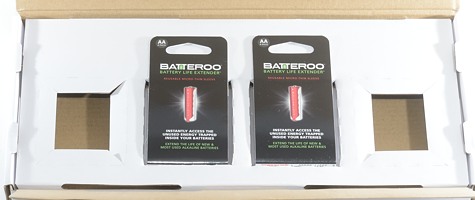





Click on the images with text to get larger versions. It is also possible to click on the images below.
The "Guarantee" is not much of a guarantee.





Electronic is hidden in the top.

A battery with the sleeve will be slightly larger than a normal AA cell.
The sleeve is metal with paint (or maybe anodising) as isolation, this means there is a risk of shorts when using multiple sleeves in a metal battery holder.
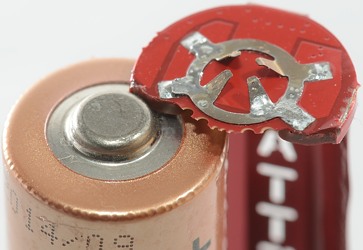
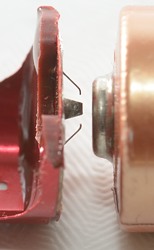
The top on the batteries must match a normal AA top in size. It do not do that for all purposes.

Here is the discharge curves for the sleeve, but for better comparison I have done a few more curves and mixed them into the same chart:

In these curves the A cell is a Duracell with the Batteroo sleeve on and the B cell is a Duracell without it. I also included a NiMH (Eneloop 2000mAh with the sleeve) for comparison, it is the C cell.
Looking at the different currents shows that the sleeve is best used at 0.5A or lower.
Comparing at different voltage and current is interesting.
A device that stops working at 1.3V and draws 0.5A will last about 4 times longer with the sleeve.
A device that stops working at 0.7V and draws 0.5A will last nearly 2 times longer without the sleeve.
At 0.5A the crossover point is at 1.1V, with devices drawing lower current the crossover point will be at a higher voltage: 0.1A is at about 1.18V
The test with the NiMH shows that Batteroo adds about 0.2V to the voltage (Check my comparator for a test without the sleeve), but with a shorter runtime.



A fairly low current test, the Duracell without sleeve can run for 11 days down to 1.1V and for 14 days down to 0.7V.
With the sleeve the runtime is 10½ day down to 1.2V and a few hours more to 1.1V and 0.7V.
From my logfile I can see that the sleeve deliver a total of 3.67Wh, without the sleeve I got 3.02Wh to 1.2V, 3.46Wh to 1.1V and 4.15Wh to 0.7V (These two batteries are not from the same pack, i.e. the comparison is not completely valid).
In this case it looks like the sleeve delivers slightly more energy to device that only work down to 1.1V, but not anywhere 8 times or even 2 times.

How much extra energy do the sleeve get from the batteries, according to these curves: none
When discharging to 1V the battery will provide more energy without the sleeve.
Technical analysis
The sleeve is a boost converter, but how much do it boost and how effective is it.
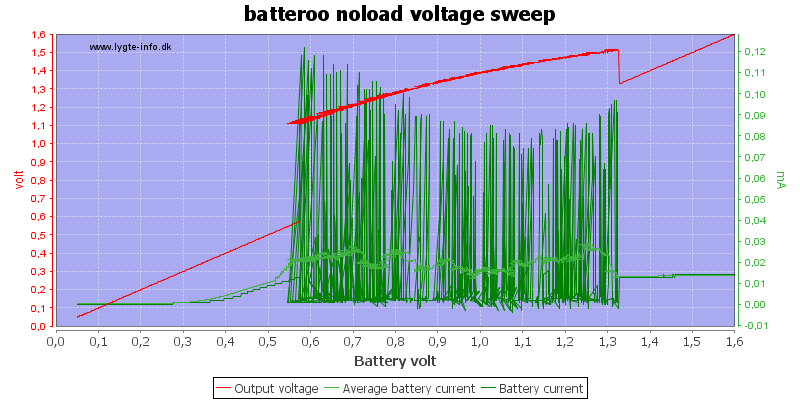
Being an active device it will consume some power from the battery, even when the device it is in is off.
Here I have analyzed the power consumption at different battery voltages. With a fresh battery it is about 15uA, when the battery is used it will increase to 20-25uA. This power consumption is not significant for AA batteries, they will last many years.

First test is at very low power (1500ohm is about 1mA), the efficiency is about 90% when the sleeve is running, but it will first start when tbe battery voltage has dropped to about 1.32V.
The battery is drained to about 0.6V before the sleeve quits.

Increasing the load to about 10mA do not change much.

At about 100mA there is some strange behavior when the sleeve starts.

Here I have replaced the resistor load with an electronic load that drains a constant current independent of the voltage.



In this curve the sleeve is on all the time, the output voltage starts above 1.6V. I have seen this a couple of times during testing. It is probably due to my test setup.
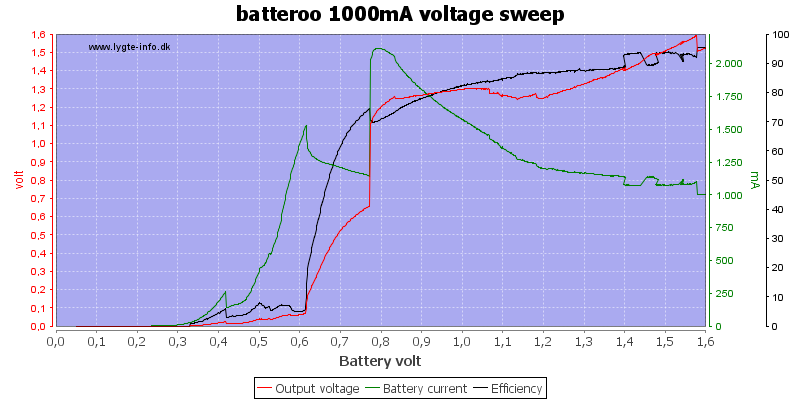
It can deliver 1A output, but drawing up to 2A from a alkaline is not going to work for long.

There is significant low frequency ripple on the output

Here is an example where it goes into full blast (See 0.5A curve above).

I captured this during my 0.2A test, the thick line is with the boost converter on and the thin lines in between is with it off.

Here I have zoomed in on the thick line and the frequency is just above 2.5MHz.

The above curves had a lot of ripple, is the sleeve really that bad or is my test setup making it worse than it really is?
I moved the testing to a normal sleeve with a battery in. Here the noise is lower.
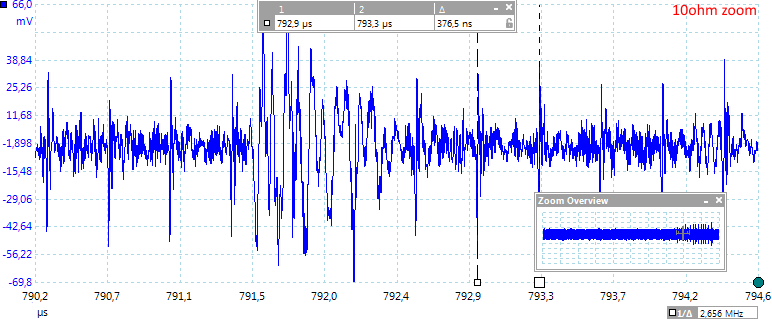
The frequency is still a bit above 2.5MHz

With a 150ohm load the low frequency ripple is back and not that different to the above.

At 1000ohm load the ripple frequency goes down.
All the spikes on the curve are not from the sleeve, but from the environment.
Test setup
My tests are made with two different setups:

For the battery discharges I added a piece of copper tape on top of the sleeve and then used it in one of my 4 terminal battery clamps. Discharge was done with an electronic load.

For all the voltage sweeps I used a power supply with 4 terminal connections instead of a battery, to avoid problems with high frequency and transients I soldered a 3uF capacitor to the sleeve. As load I either used a resistor (All tests with ohms) or a electronic load (All tests with current).
Power discussion
When looking at power consumption it is necessary to look at how different devices draw power:
- Constant resistance, this is simple resistor. When the voltage drops the current draw will drop. This usual means the device will slow down or in some other way reduce performance. Using the sleeve will increase the voltage and probably increase the performance of the device. The penalty is shorter runtime for the battery.
- Constant current, this will match a device with a linear voltage regulator. In some cases the sleeve may give more runtime for this type of devices.
- Constant power, this match most modern electronic device, it has a boost convert build in and will adjust current draw to always supply the needed voltage and power. If the build in boost converter is anywhere near decent quality the sleeve will waste 10% power and not do anything else. In some devices the build in boost converter may not work at low voltage and the sleeve will increase the runtime if added when the battery is empty (Adding it before adds a 10% waste).
Most devices will not be one of the above, but a combination where one of the types is dominant.
Conclusion
The sleeve is not really a product to save a lot of batteries with, there are probably a few products where it will increase the runtime for batteries, if it can fit in them (Many devices has a fairly tight fit on batteries).
With some devices there is also a risk that either the ripple or the switcher noise will prevent them from working correctly.
Due to the nearly constant output voltage until the battery is empty, battery meters will not really work when using this device.
To find devices where it might be useful, look for devices that have very short runtime with NiMH batteries and considerable longer with alkaline. The sleeve might be more useful with NiMH batteries than with alkaline. The question is how hard the 0.6V minimum will affect lifetime of NiMH.
As a general device to extend battery life it is not very useful, but in a very few situations it might be a useable solution.
Notes and links
Taking a battery out of a device that has stopped working and measuring the voltage on the battery will not show at what voltage the device stops working, but a much higher voltage. It must be measured with the battery powering the device.
How is the test done and how to read the charts
Compare to other AA/AAA batteries: Alkaline/NiMH/Lithium
Energy in alkaline batteries at low voltage










































